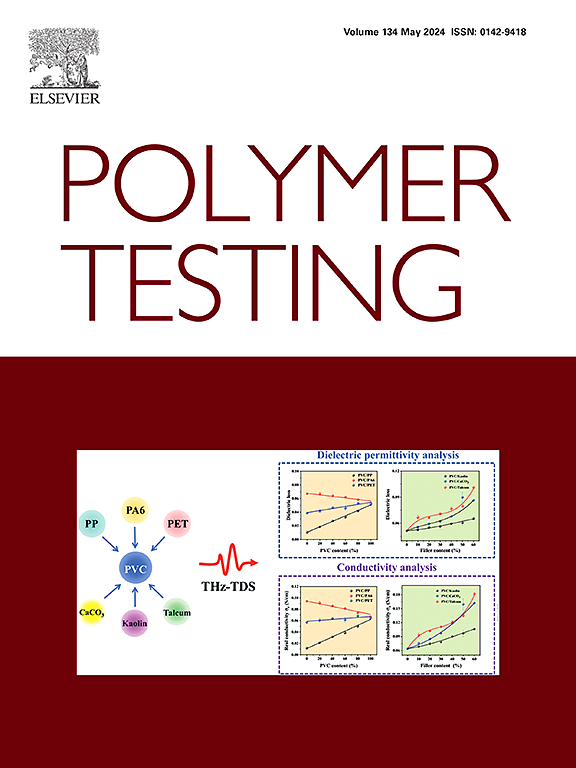High-adhesive and conductive AMPSs-TA-Fe hydrogels via E-beam-assisted rapid one-pot synthesis for strain sensor
IF 6
2区 材料科学
Q1 MATERIALS SCIENCE, CHARACTERIZATION & TESTING
引用次数: 0
Abstract
The development of high-performance hydrogels with high ionic conductivity, mechanical stability, and exceptional skin adhesion, even under wet conditions, is crucial for advancements in wearable electronics. With abundant hydroxyl groups, tannic acid (TA) is renowned for its adhesion to skin in moist environments, facilitated by coordination bonds with metal ions such as Fe3+. However, TA's radical scavenging effect complicates polymerization by UV or thermal curing, leading prior studies to adopt time-intensive, costly approaches, such as post-polymerization soaking or pre-formed polymers. Here, we used E-beam irradiation for rapid, one-pot in situ polymerization from a precursor solution of 2-Acrylamido-2-methylpropanesulfonic acid sodium salt (AMPSs), TA, and Fe ions, incorporating all components in a single step. We report the successful synthesis of a multifunctional hydrogel with exceptional skin adhesion, high ionic conductivity, strong mechanical strength, excellent recovery, and self-healing properties, all achieved through a simple one-pot electron beam curing method in just 13.89 s. This remarkable curing time contrasts with the lengthy durations (1–8 h) of conventional TA-incorporating methods, eliminating the need for heat or UV initiators. The resulting P(AMPSs-TA-Fe) hydrogel exhibited high skin adhesion (154.53 N/m) due to TA-Fe coordination and excellent ionic conductivity (2.71 S/m) from AMPSs, Fe3+ ions, and TA's ion-bridging effect. The reversible TA-Fe bonding also imparted strong fatigue resistance (1.32 kJ/m3 at 200 % strain) and self-healing, enabling conductivity recovery within 2.4 s after damage. Overall, the P(AMPSs-TA-Fe) hydrogel shows great promise for flexible sensors, combining robust mechanical performance, excellent skin adhesion, high ionic conductivity, and rapid self-healing.
通过电子束辅助快速一锅合成用于应变传感器的高粘接和导电amps - ta - fe水凝胶
高性能水凝胶的开发具有高离子电导率,机械稳定性和优异的皮肤附着力,即使在潮湿条件下,对可穿戴电子产品的进步至关重要。由于含有丰富的羟基,单宁酸(TA)因其在潮湿环境中与皮肤的附着力而闻名,这是通过与金属离子如Fe3+的配位键来促进的。然而,TA的自由基清除作用使紫外线或热固化的聚合变得复杂,导致先前的研究采用耗时、昂贵的方法,如聚合后浸泡或预成型聚合物。在这里,我们使用电子束辐照从2-丙烯酰胺-2-甲基丙磺酸钠盐(AMPSs), TA和Fe离子的前驱体溶液中进行快速,一锅原位聚合,将所有成分在一个步骤中结合。我们成功合成了一种多功能水凝胶,具有优异的皮肤粘附性,高离子电导率,强机械强度,良好的恢复和自愈性能,所有这些都是通过简单的一锅电子束固化方法在13.89秒内完成的。这种显著的固化时间与传统ta结合方法的长时间(1-8小时)形成鲜明对比,不需要加热或紫外线引发剂。得到的P(amps -TA- fe)水凝胶由于TA- fe配位和优异的离子电导率(2.71 S/m),以及amps、Fe3+离子和TA的离子桥接作用,具有较高的皮肤粘附力(154.53 N/m)。可逆的TA-Fe键合还具有很强的抗疲劳性(200%应变时为1.32 kJ/m3)和自修复能力,在损伤后2.4 s内恢复电导率。总的来说,P(AMPSs-TA-Fe)水凝胶结合了强大的机械性能、优异的皮肤粘附性、高离子导电性和快速自愈性,在柔性传感器方面表现出很大的希望。
本文章由计算机程序翻译,如有差异,请以英文原文为准。
求助全文
约1分钟内获得全文
求助全文
来源期刊

Polymer Testing
工程技术-材料科学:表征与测试
CiteScore
10.70
自引率
5.90%
发文量
328
审稿时长
44 days
期刊介绍:
Polymer Testing focuses on the testing, analysis and characterization of polymer materials, including both synthetic and natural or biobased polymers. Novel testing methods and the testing of novel polymeric materials in bulk, solution and dispersion is covered. In addition, we welcome the submission of the testing of polymeric materials for a wide range of applications and industrial products as well as nanoscale characterization.
The scope includes but is not limited to the following main topics:
Novel testing methods and Chemical analysis
• mechanical, thermal, electrical, chemical, imaging, spectroscopy, scattering and rheology
Physical properties and behaviour of novel polymer systems
• nanoscale properties, morphology, transport properties
Degradation and recycling of polymeric materials when combined with novel testing or characterization methods
• degradation, biodegradation, ageing and fire retardancy
Modelling and Simulation work will be only considered when it is linked to new or previously published experimental results.
 求助内容:
求助内容: 应助结果提醒方式:
应助结果提醒方式:


